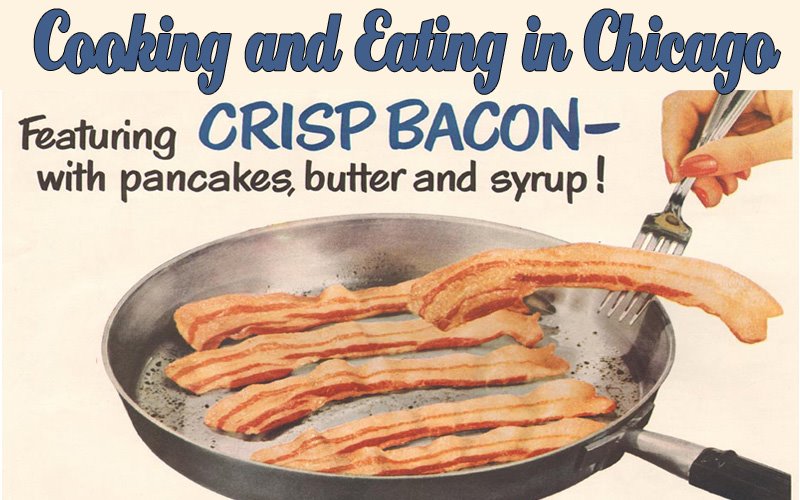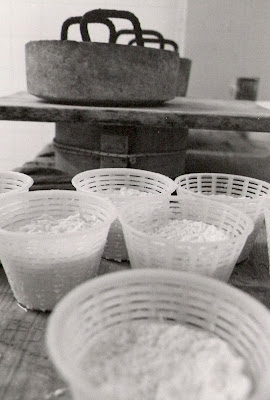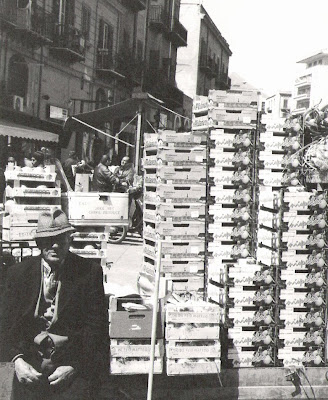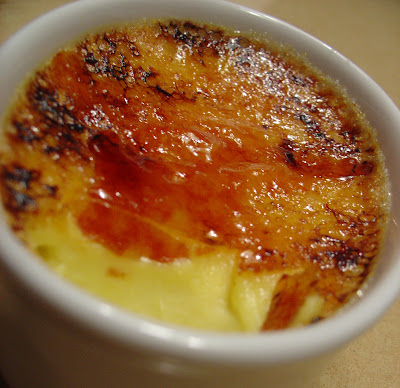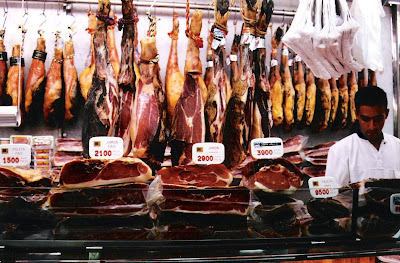
Stuff that works is good. Stuff that lasts a long time and works is really good. Stuff that works, lasts a long time, and costs less than twenty bucks is worth blogging about. (Although some people seem to think their bellybutton lint is worth blogging about).
At any rate, I will now sing the praises of the Benriner Japanese Mandoline Slicer (pictured above). This little gem does everything the big, expensive, stainless steel mandolines do, for a fraction of the price. Plus, it's easier to clean, easier to change/replace the julienne teeth on, and....did I mention how friggin' cheap it is?
Ok, some background; basically, a mandoline is a device that houses a very sharp blade in a body that allows the user to slide a piece of food (like, say, a potato) across it, yielding a very thin, even slice (like, say, for a potato chip). Most have additional attachments that add teeth to the blade so that the thin slice can also be cut cross-wise at the same time it's sliced, producing uniform julienne strips. They're widely used in restaurant kitchens because they allow cooks to do things more consistently and faster than they could do with their knives.
Most restaurant kitchens use
this mandoline. It's French, made by a company called Bron, and costs about $200. It works well, although it's kind of tricky to configure--you have to flip the base/support thingy around a few different ways to get it to stand the way you want--and also, the teeth tend to get bent after a while. But it's a good product. It works.
I will now digress with a story; when I was in culinary school, I landed my first real restaurant job. I was making $6.50 an hour at a now-defunct place called Spruce here in Chicago. I had never worked in a restaurant before and had been in culinary school for about 9 months. This was where I first encountered a mandoline. Of course, the moment I first encountered this device, we were deep in the shit, way behind, and the fire-breathing Napolean running the show was screaming for something--I can't quite remember what--but I do know that it involved cutting some sort of root vegetable razor-thin on a mandoline.
So I
ran to the cooler, plunged my hands into buckets filled with ice cold water and the root vegetable in question, neatly peeled in quantity ahead of time,
ran back to my station near the fryolator, and set up the mandoline as quickly as I could, after which, I began slicing, frantically, the desperately-needed root vegetable (I think it was taro...or maybe yucca) so that chips could be made. Chips on which, I was led to believe, the entire success of the restaurant depended.
Victory! As my hand worked the root vegetable across the blade of the mandoline in a blur, a pile of paper-thin slices began to accumulate beneath the device. Another cook swept them into the fryer as fast as I could slice them and the highly in-demand chips were produced. Crisis of the moment averted. The fate of the restaurant was secure! "Don't forget to season them, you stupid piece of shit!", the little genius chef barked as his beady little eyes spotted them emerging from the fryer. "Yes, chef!", I replied, pleasantly surprised by his acknowledgment of my hard work. He was clearly impressed by my speed and prowess.
But as the emergent situation resolved itself and the yucca (or taro) chips were placed perilously atop the dish for which they would serve as the essential garnish, I noticed something strange. Why was my cutting board all red? What's all this mess under my mandoline.....? Wait....is that....?
Yep. Blood. My blood. A
lot of it.
These mandolines are sharp. Sickeningly, frighteningly sharp. So sharp was the blade of this brand-new mandoline, that I had run my four fingertips, along with the side of my thumb, across the blade multiple times without even feeling it. Of course, once the heat of the moment passed and I saw the blood, my brain stem finally re-connected with the nerves in my fingers and the pain hit me all at once, blindingly.
Suffice to say that I worked the rest of the shift with two rubber gloves on my hand and my fingers looked like wooden matchsticks because the tips kept bleeding and the blood built up in the fingertips, reservoir-tip style, and balooned up. Cuts inflicted by really sharp blades take forever to stop bleeding.
That little story is intended to serve as the disclaimer for this piece of equipment. Warning--blades are sharp. It's written on the box too, but I think my anecdote makes a stronger impression.
Getting back to the subject at hand, the Benriner's blade is equally sharp. Did I mention it's
twenty bucks? Less, even. I saw one at
H-Mart the other day for like fifteen.
So what's the difference between the cheapie and other mandolines like the
$400 Shun model, the above-mentioned Bron, or the as-seen-on-tv
V-slicer?
Not much. The Benriner can't do gaufrettes (aka "waffle-cut"). So, if that's a deal-breaker, you can shell out the extra $180. That'll buy you a lot of trips to Arby's. Or, you could just buy yourself
an old fashioned krinkle cutter for five bucks and use the $175 you have left to buy like 700 pounds of potatoes. Is anyone really making waffle-cut fries at home anyway?
Other than that, the wonder-cheapie does everything the big, heavy, shiny mandolines can do. Seriously. The expensive ones almost certainly have better blades that will last longer, but you can buy ten Benriners for the same price as one Bron, and I guarantee that the Bron's blade won't last ten times as long. I've had the same Benriner for about four years now and it's fine.
What else? Well, the plastic on the lil' cheapster gets stained. Mine's kind of an ugly red/orange color from doing carrots and beets on it, and it won't wash off. The color is somehow kind of impregnated into the plastic. What. Ever. Again, if this bugs you, toss it and buy another. They're twenty bucks. But it doesn't bug me. I don't need my kitchen tools to be shiny. Or even clean.
What else can I tell you? You'll lose some of the teeth, but you can buy replacements for about five bucks. DO NOT lose the screw that adjusts the slice thickness. I worked with a guy once who always lost the most important little element of any machine and he always tried to jimmy it up with wooden skewers. I spent way too much of my life adjusting the broken bits of skewer that he'd jammed into the lid of the robot coupe, the screw adjustment on the mandoline, and the ice cream spinner. Just don't unscrew it all the way.
Common sense. Such is life. Why spend $200 when you can get almost the same thing for $20? You'd be surprised how many people would when the $200 version is shiny, French, and the only one they sell at Macy's, Williams-Sonoma, or wherever. Don't do it. Buy the cheap little Benriner and use the money you save to buy more root vegetables.


